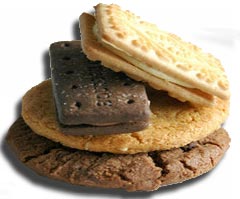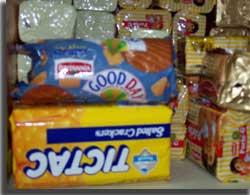| Size of the INDUSTRY | The production capacity of wafer biscuits is 60 MT and the cost is Rs.56,78,400 with a motive power of 25 K.W. |
| Geographical distribution | Maharashtra, West Bengal, Andhra Pradesh, Karnataka, and Uttar Pradesh. |
| Output per annum | Biscuit industry contribute Rs 8,000 crore to the FMCG industry today provides vast opportunity |
| Percentage in world market | Indian subcontinent is known to be the second largest manufacturer of biscuits, the first being USA. |

In the year 1990 the total production of bakery products have risen from 5.19 lakh tonnes in 1975 to 18.95 lakh tonnes. Today Biscuits contributes to over 33 % of the total production of bakery and above 79 % of the biscuits are manufactured by the small scale sector of bakery industry comprising both factory and non-factory units in the country. The production capacity of wafer biscuits is 60 MT and the cost is Rs.56, 78,400 with a motive power of 25 K.W. Indian biscuit industry has occupied around 55-60 % of the entire bakery production. Today the large scale bakery manufacturers like Cadbury, Nestle, and Brooke bond had traded in the biscuit industry but couldn't hit the market because of the local companies that produced only biscuits. Government has established The Federation of Biscuit Manufacturers of India (FBMI) which has confirmed a bright future of India Biscuits Industry in the year 1953. According to FBMI, a steady growth of 15 % per annum in the next 10 years will be achieved by the biscuit industry of India. Besides, the export of biscuits will also surpass the target and hit the global market successfully.

Biscuit is always hygienically packaged nutritious snack food available at very competitive prices, volumes and different tastes. According to the NCAER analysis, biscuits are predominantly consumed by people from the lower strata of society, particularly children in both rural and urban areas with an average monthly income of Rs. 750and above.
The organized biscuit manufacturing industries annual production
| Year | Annual Production(Lakh MT) |
| 2003-04 | 11.00 |
| 2004-05 | 12.54 |
| 2005-06 | 14.29 |
| 2006-07 | 16.14 |
| 2007-08 | 17.14 |
| 2008-09 | 19.5 |
The Indian Biscuit industry for the organized sector produces around 60% of the total production, the balance 40% being contributed by the unorganized bakeries. The industry consists of two large scale manufacturers, around 50 medium scale brands and small scale units ranging up to 2500 units in the country, as at 2000-01. The unorganized sector is estimated to approximately have 30,000 small & tiny bakeries across the country.
- Parle
- Britannia
- Sunfeast
- Priya Gold
- Cremica
- Dukes
- Anmol
- Horlicks
- Biskfarm
- Rose
- Sobisco
- Nezone
- Indian biscuit market is 1.1 million tonnes per annum at Rs 50 billion. About 90% of Indians buy and eat biscuits.
- According to estimates the bakery industry in India is worth Rs 69 billion. Out of which bread and biscuits hold about 82% of the share. The bread market has a business volume of 1.5 million tonnes. The major factors for growth in this segment are: Brand loyalty, volumes and strong distribution networks.
- Growth in the over 40-year-old Indian biscuit industry has remained slow. The analyst's calculations will show that per capita consumption is less than Rs 3 per month on biscuits or less than Rs 15 per household per month.
- Back in 2003, nobody thought Sunfeast would have consumers eating out of its hands.
- According to the AC Nielsen retail sales audit in March 2006, both Britannia and Parle have lost volumes. Britannia's shares have dropped from 35.8 % in 2004-05 to 30.5 % in May 2006 (volumes). Parle's shares have also dropped from 42.2 to 38.4 % in the same period.
- Even Priya Gold has seen a minor dip from 6.4 % to 5 %. ITC's Sunfeast has been a big gainer with its share increasing from 2.7 to 6.7 %.
 Recent Press Release
Recent Press Release
 INDIAN biscuit industry AT A Glance IN 2021 - 2022
INDIAN biscuit industry AT A Glance IN 2021 - 2022
 INDIAN biscuit industry AT A Glance IN 2020 - 2021
INDIAN biscuit industry AT A Glance IN 2020 - 2021
 INDIAN biscuit industry AT A Glance IN 2019 - 2020
INDIAN biscuit industry AT A Glance IN 2019 - 2020
 INDIAN biscuit industry AT A Glance IN 2018 - 2019
INDIAN biscuit industry AT A Glance IN 2018 - 2019
 INDIAN biscuit industry AT A Glance IN 2017 - 2018
INDIAN biscuit industry AT A Glance IN 2017 - 2018
 INDIAN biscuit industry AT A Glance IN 2016 - 2017
INDIAN biscuit industry AT A Glance IN 2016 - 2017
 INDIAN biscuit industry AT A Glance IN 2015 - 2016
INDIAN biscuit industry AT A Glance IN 2015 - 2016
 INDIAN biscuit industry AT A Glance IN 2014 - 2015
INDIAN biscuit industry AT A Glance IN 2014 - 2015
 INDIAN biscuit industry AT A Glance IN 2013 - 2014
INDIAN biscuit industry AT A Glance IN 2013 - 2014
 INDIAN biscuit industry AT A Glance IN 2012 - 2013
INDIAN biscuit industry AT A Glance IN 2012 - 2013
 INDIAN biscuit industry AT A Glance IN 2011 - 2012
INDIAN biscuit industry AT A Glance IN 2011 - 2012
 Indian Biscuit Manufactures Association
Indian Biscuit Manufactures Association
Indian Industries



 INDIAN BISCUIT INDUSTRY
INDIAN BISCUIT INDUSTRY